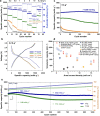Three-dimensional hierarchically porous MoS2 foam as high-rate and stable lithium-ion battery anode
- PMID: 36224249
- PMCID: PMC9556660
- DOI: 10.1038/s41467-022-33790-z
Three-dimensional hierarchically porous MoS2 foam as high-rate and stable lithium-ion battery anode
Abstract
Architected materials that actively respond to external stimuli hold tantalizing prospects for applications in energy storage, wearable electronics, and bioengineering. Molybdenum disulfide, an excellent two-dimensional building block, is a promising candidate for lithium-ion battery anode. However, the stacked and brittle two-dimensional layered structure limits its rate capability and electrochemical stability. Here we report the dewetting-induced manufacturing of two-dimensional molybdenum disulfide nanosheets into a three-dimensional foam with a structural hierarchy across seven orders of magnitude. Our molybdenum disulfide foam provides an interpenetrating network for efficient charge transport, rapid ion diffusion, and mechanically resilient and chemically stable support for electrochemical reactions. These features induce a pseudocapacitive energy storage mechanism involving molybdenum redox reactions, confirmed by in-situ X-ray absorption near edge structure. The extraordinary electrochemical performance of molybdenum disulfide foam outperforms most reported molybdenum disulfide-based Lithium-ion battery anodes and state-of-the-art materials. This work opens promising inroads for various applications where special properties arise from hierarchical architecture.
© 2022. The Author(s).
Conflict of interest statement
The authors declare no competing interests.
Figures





Similar articles
-
Facile CVD Fabrication of Vertically Aligned MoS2 Nanosheets with Embedded MoO2 on Molybdenum for High-Performance Binder-Free Lithium-Ion Battery Anodes.ACS Omega. 2024 Dec 2;9(50):49867-49877. doi: 10.1021/acsomega.4c08704. eCollection 2024 Dec 17. ACS Omega. 2024. PMID: 39713695 Free PMC article.
-
Carbon nanofibers decorated with molybdenum disulfide nanosheets: synergistic lithium storage and enhanced electrochemical performance.Angew Chem Int Ed Engl. 2014 Oct 20;53(43):11552-6. doi: 10.1002/anie.201407103. Epub 2014 Sep 11. Angew Chem Int Ed Engl. 2014. PMID: 25213751
-
Interconnected Vertically Stacked 2D-MoS2 for Ultrastable Cycling of Rechargeable Li-Ion Battery.ACS Appl Mater Interfaces. 2019 Jun 12;11(23):20762-20769. doi: 10.1021/acsami.9b02359. Epub 2019 Jun 3. ACS Appl Mater Interfaces. 2019. PMID: 31157525
-
Molybdenum Disulfide Based Nanomaterials for Rechargeable Batteries.Chemistry. 2020 May 20;26(29):6296-6319. doi: 10.1002/chem.201905524. Epub 2020 Feb 26. Chemistry. 2020. PMID: 31967372 Review.
-
MoS2-Based Nanocomposites for Electrochemical Energy Storage.Adv Sci (Weinh). 2016 Dec 6;4(2):1600289. doi: 10.1002/advs.201600289. eCollection 2017 Feb. Adv Sci (Weinh). 2016. PMID: 28251051 Free PMC article. Review.
Cited by
-
Insight into the Storage Mechanism of Sandwich-Like Molybdenum Disulphide/Carbon Nanofibers Composite in Aluminum-Ion Batteries.Nanomaterials (Basel). 2024 Feb 28;14(5):442. doi: 10.3390/nano14050442. Nanomaterials (Basel). 2024. PMID: 38470773 Free PMC article.
-
Self-Supporting Quasi-1D TaS3 Nanofiber Films with Dual Cationic/Anionic Redox for High-Performance Mg-Li Hybrid Ion Batteries.ACS Appl Mater Interfaces. 2025 Aug 6;17(31):44513-44527. doi: 10.1021/acsami.5c09460. Epub 2025 Jul 23. ACS Appl Mater Interfaces. 2025. PMID: 40698868 Free PMC article.
-
Ultrathin Two-Dimensional Fe-Co Bimetallic Oxide Nanosheets for Separator Modification of Lithium-Sulfur Batteries.Molecules. 2022 Nov 11;27(22):7762. doi: 10.3390/molecules27227762. Molecules. 2022. PMID: 36431863 Free PMC article.
-
Monodisperse MoS2/Graphite Composite Anode Materials for Advanced Lithium Ion Batteries.Molecules. 2023 Mar 19;28(6):2775. doi: 10.3390/molecules28062775. Molecules. 2023. PMID: 36985749 Free PMC article.
-
Atomic-Scale In Situ Scanning Transmission Electron Microscopy of MoS2 during Lithiation.ACS Nano. 2025 Aug 5;19(30):27332-27337. doi: 10.1021/acsnano.5c05218. Epub 2025 Jul 21. ACS Nano. 2025. PMID: 40691048 Free PMC article.
References
Grants and funding
LinkOut - more resources
Full Text Sources

